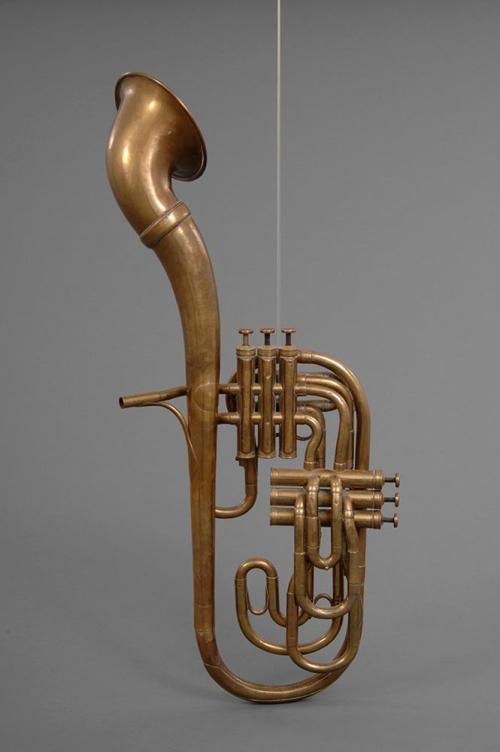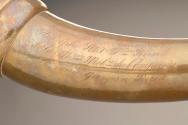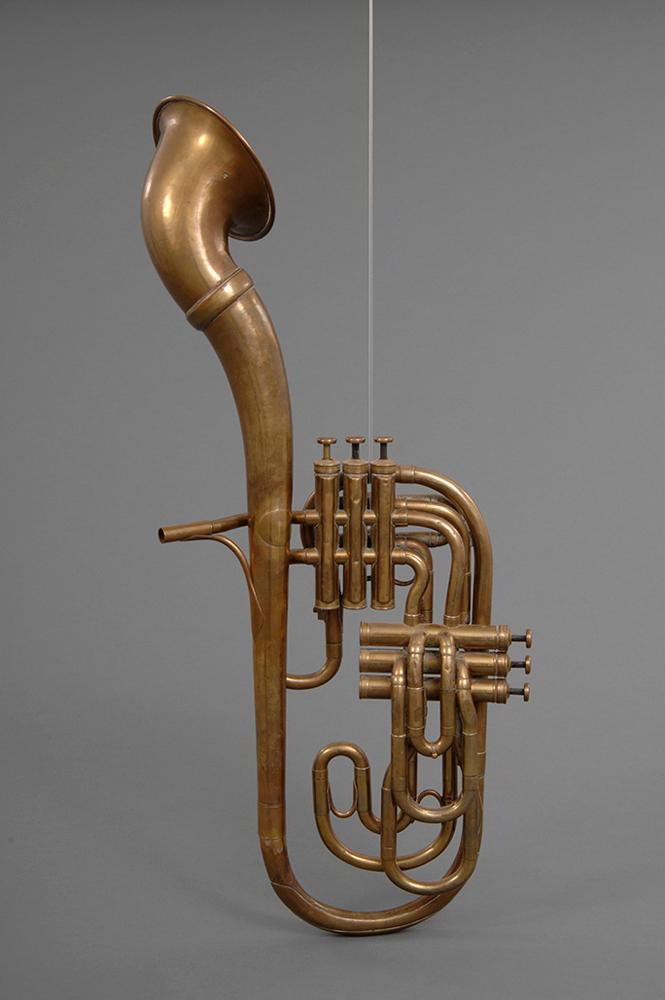Home
>
Works
>
Alto saxhorn, E-flat
>
Advanced Search
Alto saxhorn, E-flat
Maker: Adolphe Sax
Date: 1866
Place Made:Paris, France, Europe
Model: Nouveau saxhorn alto
Serial No: 32360
SignedEngraved and stamped on bell: No,, 32360 / Nouveau saxhorn alto en mib / Adolphe Sax Fteur Breveté / de la Mson Milre de l’Empereur / 50, rue st,, Georges Paris / AS (monogram) PARIS (inserted within S of monogram) / SEU[L] / [GRAND] PRIX / 18[67]
MarkingsStamped on outside of bell: AT
Stamped on inside of bell: DB
Stamped on valve casings and upper valve caps, respectively: 1, 2, 3, 4, 5, 6
Stamped on inside of bell: DB
Stamped on valve casings and upper valve caps, respectively: 1, 2, 3, 4, 5, 6
DescriptionBrass, triple loop, fixed horizontal leadpipe, upright angled bell (originally turnable, now fixed), tuning slide at second loop, six independent Périnet valves ascending in semitone steps (first valve shortest tubing, no valve longest tubing), valves 1–3 horizontal, valves 4–6 vertical, bottom-sprung, alignment by one key on piston (nickel-silver), valve casing with channel, no hole in bottom valve caps, windway passes through each valve twice 1-2-3-4-5-6 and returning 6-5-4-3-2-1.
Sax patented the system of six independent valves in 1859 (addition to brevet français no. 39371, dated December 29, 1859). This system offered perfect intonation by avoiding any valve combinations. However, the resulting instruments were very heavy and required the player to learn a completely new fingering system. As a result, the system was not widely accepted. In the initial patent submission from January 1859 (brevet français no. 39371), Sax specified improved valve casings in which the air below the piston was directed to the space above it (when depressed) in a channel on the side of the valve casing. The idea was to avoid a hole in the bottom valve cap to prevent dust from entering. This design was too complicated to be accepted by mainstream brasswind production.
Sax patented the system of six independent valves in 1859 (addition to brevet français no. 39371, dated December 29, 1859). This system offered perfect intonation by avoiding any valve combinations. However, the resulting instruments were very heavy and required the player to learn a completely new fingering system. As a result, the system was not widely accepted. In the initial patent submission from January 1859 (brevet français no. 39371), Sax specified improved valve casings in which the air below the piston was directed to the space above it (when depressed) in a channel on the side of the valve casing. The idea was to avoid a hole in the bottom valve cap to prevent dust from entering. This design was too complicated to be accepted by mainstream brasswind production.
DimensionsHeight: ca. 710 mm
Tube length (lengths first to sixth valves, followed by open instrument): 1950 mm, 2052 mm, 2175 mm, 2330 mm, 2475 mm, 2610 mm, 2785 mm
Bore diameter (initial, minimum, tuning slide, valve slides): 10.5 mm, 10.3 mm, 12.7–12.8 mm, 11.3–12 mm
Bell diameter: 135–140 mm
Tube length (lengths first to sixth valves, followed by open instrument): 1950 mm, 2052 mm, 2175 mm, 2330 mm, 2475 mm, 2610 mm, 2785 mm
Bore diameter (initial, minimum, tuning slide, valve slides): 10.5 mm, 10.3 mm, 12.7–12.8 mm, 11.3–12 mm
Bell diameter: 135–140 mm
ProvenancePurchased in 1992 from Tony Bingham, London, England.
Terms
Credit Line: Joe R. and Joella F. Utley Collection, 1999
Not on view
Published ReferencesSabine Katharina Klaus, Trumpets and Other High Brass: A History Inspired by the Joe R. and Joella F. Utley Collection. Volume 4: The Heydey of the Cornet (Vermillion, SD: National Music Museum, 2022), pp. 215-16, 292.
Evgenia Mitroulia, “Adolphe Sax’s Brasswind Production with a Focus on Saxhorns and Related Instruments,” doctoral dissertation, School of Arts, Culture and Environment, College of Humanities and Social Science, University of Edinburgh, 2011, p. 440.
Evgenia Mitroulia, “Adolphe Sax’s Brasswind Production with a Focus on Saxhorns and Related Instruments,” doctoral dissertation, School of Arts, Culture and Environment, College of Humanities and Social Science, University of Edinburgh, 2011, p. 440.
Object number: 07076






